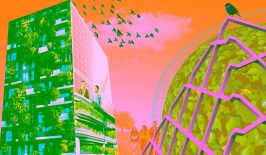In Berlin’s Neukölln district, the building cooperative TRNSFRM is constructing a residential building from old stones, windows and doors, otherwise known as circular construction or circular building. Their four-storey CRCLR building, scheduled for completion in summer 2024, is being constructed on top of the existing foundation walls of the former historic Kindl brewery complex. Once construction is complete, the building will have around 2,500 square metres of residential space and approximately 2,300 square metres of commercial space. With this project, TRNSFRM aims to create affordable, sustainable and community-oriented housing in a city which sorely needs it.
FACTS: CIRCULAR BUILDING
Circular construction is about reusing and recycling buildings, their components and materials so that they remain in use for as long as possible.
The three most important circular approaches are:
- Preservation of existing structures
- Reuse of materials and components already in the cycle; remanufacture or recycle where appropriate (for example, R-concrete).
- Recyclable designs of resource-conserving and low-emission materials and components that can be easily deconstructed and reused or recycled (e.g. curtain walls).
All three approaches can be combined with each other.
The proper documentation of the used materials and components both simplifies the circular economy and cam even make it possible in the first place.
As nice as the idea of circular building sounds, its implementation is not always straightforward. For one, finding available, used building materials in sufficient quantities is often a struggle. For example, component exchanges often only have a limited amount of material available; a professional market for used components does not currently exist. “You can’t build a house on [anything],” explains Simon Lee, co-chairman of TRNSFRM. Therefore, a higher level of transparency and stronger networking in the second-hand construction sector is what needs to happen.
Does a digital material passport mean more transparency?
Work is currently underway on various sustainable solutions for the building industry. One digital tool that aims to advance circular building is the digital Madaster material passport. Developed in the Netherlands and with projects ongoing in around six European counties, “The Madaster material passport gives building materials an identity. This prevents them from disappearing into anonymity as waste,” reports project co-founder Thomas Rau.
Theoretically, the process is simple enough. Through comprehensive data collection using Building Information System (BIM), all available building information is first collected. Madaster, as a central online platform, then stores, manages and exchanges the collected information on the materials used. Thus, the tool can be understood as a digital record, or cadastre, specifically for the construction industry.
The building’s material passport, created from the digital copy, identifies its quality, origin and location. But it also contains much more information. For example, chemical ingredients, product compositions, recycling proportions and figures on the life cycle assessment and recyclability of building materials are also rigorously documented. All this information simplifies both finding the correct material, as well as the circular and financial residual value of a building.
Focus on the entire circular economy
The German company Concular has developed a similar approach with its digital building resource passport. The passport is intended to provide owners with an overview of their properties and their potential for circular construction in all life cycle phases of the buildings. It also optimises building circularity with the help of the passport, supporting from planning, to renovation, to deconstruction — and back again.
Here, too, the key to life cycle assessment and circularity evaluation is the acquisition of relevant data from BIM’s analysis. Parameters such as the Circularity Performance Index (CPI) enable a quantitative assessment of individual components and consequently of the entire building in terms of its circularity. The CPI is intended to show the extent to which the individual materials and components can be returned to the cycle at the end of the building’s service life.
Compared to Madaster’s approach, Concular sees itself as a provider that goes one step further and “performs the complete cycle”, explains Concular co-founder Dominik Campanella.
Does the digital material passport bring momentum to circular construction?
In addition to a motivated building owner, the successful implementation of circular building also requires the creation of a platform for the exchange of used materials. Concular and similar initiatives create the basis on which a corresponding system could be built.
Buildings are a CO2 heavyweight: the construction, heating, cooling and disposal of our homes accounts for around 40 percent of Germany’s CO2 emissions. We will only achieve our climate goals if these emissions are massively reduced.
But how can we achieve the sustainable transformation of buildings and what role do digital solutions play in this? The RESET Greenbook provides answers: Building transformation – intelligently transforming houses and neighbourhoods.
In the future, this demand is likely to increase even further due to regulations such as the EU Taxonomy for Sustainable Activities. The EU Taxonomy serves as an instrument for the uniform categorisation of economic activities regarding sustainability. Six environmental goals form the basis for the assessment, all with the intention of protecting the environment. In addition to the obvious ones, namely climate protection and adaptation to climate change, they also include the transition to a circular economy.
This means that companies must comply with certain minimum requirements for the environmental goals — a digital material passport can support them in this. For example, according to EU Taxonomy, at least 50 per cent of the existing building must be preserved in the case of a building renovation. In a new building, at least 15 percent used, 15 percent recycled and 20 percent combined materials from both categories or renewable materials must be used.
In Germany alone, there are huge stores of raw and building materials. The German Federal Environment Agency estimates the size of this stockpile at around 52 billion tonnes of material. Globally, it is almost impossible to calculate. Most of these materials, however, are already locked in buildings and inaccessible for second-hand construction. However, through redevelopment or demolition, these materials are released. Now the question is how to use them. Without appropriate solutions such as the digital material passport, they could disappear into landfill. Even though, as the CRCLR house shows, they could easily still be fit for purpose.










